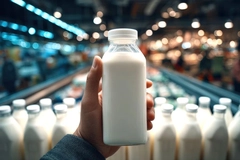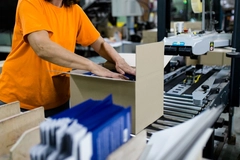KHS releases rPET bottle with glued-in handle to cut 30% material and reduce energy usage
20 Oct 2022 --- KHS has made a new development to its rPET containers for the home care and food sectors. Bottle handles are now slotted into place mechanically, and the company is offering a new glued-in process that uses preferential heating for the stretch blow molding process.
KHS says its PET bottles are more stable than the extrusion-blow-molded polyolefin alternatives currently available on the market.
Glued-in handles also require a simpler contour than clip-in varieties, which saves on material and increases efficiency, the group claims. Both the bottle body and handle are fully recyclable and made of rPET.
“Our adhesive technology enables us to cut down on the amount of energy and material used in production and manufacture a container that’s both more stable and visually more appealing than the standard products currently available on the market,” says Sebastian Wenderdel, PET sales business development manager at KHS in Hamburg, Germany.
The development of the 2.3-liter PET bottle with a glued-in handle resulted from one-and-a-half-year cooperation between KHS and Logoplaste Innovation Lab.
The aim was to design a bottle specifically for home care products with the smallest possible carbon footprint.
.jpg) KHS says using recycled PET is increasingly important as energy prices rise.Reduced energy consumption
KHS says using recycled PET is increasingly important as energy prices rise.Reduced energy consumption
Direct comparison with clip-in handles shows that up to 30% fewer resources are used in manufacturing, with 10% in material saved.
KHS says the energy efficiency provided by stretch blow molding is a considerable advantage given the recent skyrocketing prices for energy and raw materials.
In conjunction with preferential heating, KHS says it also provides a “precise and reliable piece of plant equipment.” The heating method permits homogeneous distribution of the material during the process in plastic bottles with irregular and complex designs, lowering the number of resources used and boosting bottle stability.
Neck alignment with millimeter accuracy as an optional component also allows precise product dosing with the help of oriented spout caps. Since the new PET bottle does not have any seams – as opposed to those on standard containers made of HDPE or PP – has proved convincing in rigorous in-house drop tests, claims Wenderdel.
When selecting a suitable adhesive, the design team drew on the years of expertise accumulated by KHS during the Nature MultiPack project. “The transparent PET material makes the product visible,” Wenderdel states.
rPET troubles
Wenderdel draws attention to the high rate of circularity in the PET market, which has the highest rate of recycling in the world. This makes KHS’ latest release preferable to options using PP or HDPE, he says.
However, industry is also currently facing pressure in sourcing rPET as the price of recycled plastic is rising beyond the affordable means of most companies.
Recently, UNESDA Soft Drinks Europe called for help from the European Commission as much of what is recycled in the PET bottling market is bought by other industries such as textiles and automotive. This has sent the price of rPET soaring, with UNESDA saying it is becoming “as expensive as gold.”
Edited by Louis Gore-Langton











